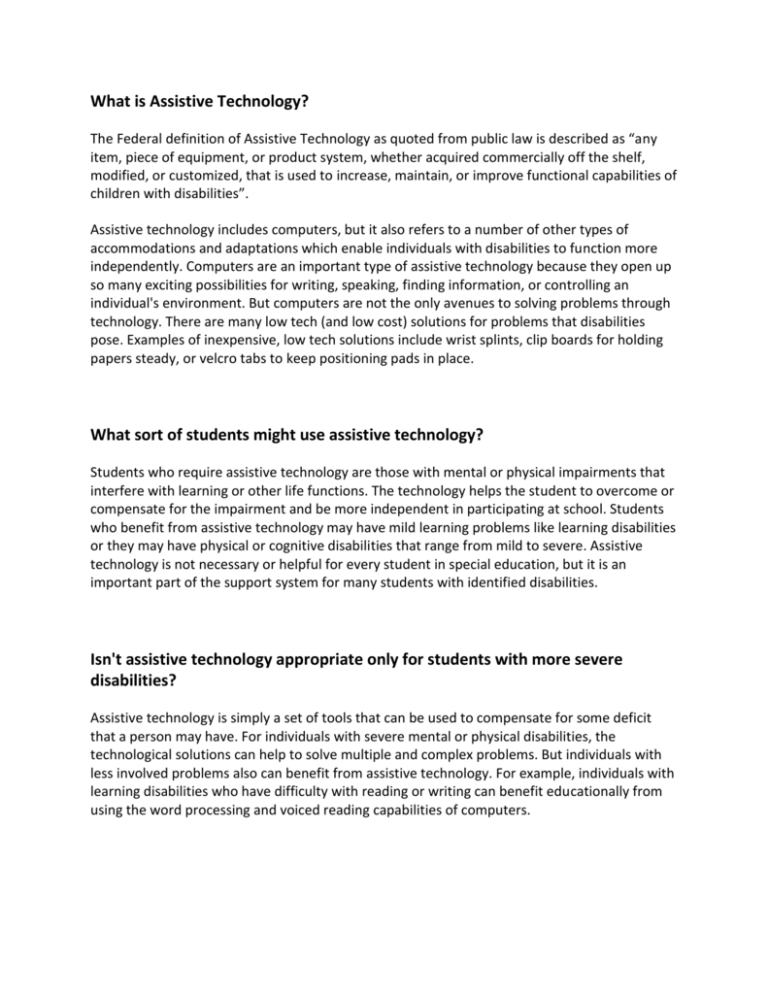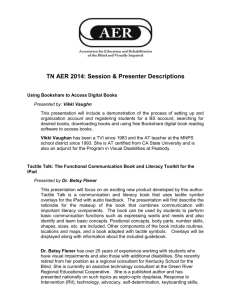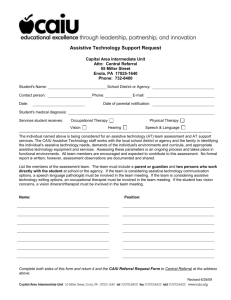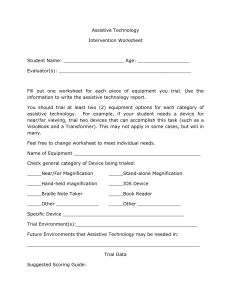AT Device Continuums
advertisement

What is Assistive Technology? The Federal definition of Assistive Technology as quoted from public law is described as “any item, piece of equipment, or product system, whether acquired commercially off the shelf, modified, or customized, that is used to increase, maintain, or improve functional capabilities of children with disabilities”. Assistive technology includes computers, but it also refers to a number of other types of accommodations and adaptations which enable individuals with disabilities to function more independently. Computers are an important type of assistive technology because they open up so many exciting possibilities for writing, speaking, finding information, or controlling an individual's environment. But computers are not the only avenues to solving problems through technology. There are many low tech (and low cost) solutions for problems that disabilities pose. Examples of inexpensive, low tech solutions include wrist splints, clip boards for holding papers steady, or velcro tabs to keep positioning pads in place. What sort of students might use assistive technology? Students who require assistive technology are those with mental or physical impairments that interfere with learning or other life functions. The technology helps the student to overcome or compensate for the impairment and be more independent in participating at school. Students who benefit from assistive technology may have mild learning problems like learning disabilities or they may have physical or cognitive disabilities that range from mild to severe. Assistive technology is not necessary or helpful for every student in special education, but it is an important part of the support system for many students with identified disabilities. Isn't assistive technology appropriate only for students with more severe disabilities? Assistive technology is simply a set of tools that can be used to compensate for some deficit that a person may have. For individuals with severe mental or physical disabilities, the technological solutions can help to solve multiple and complex problems. But individuals with less involved problems also can benefit from assistive technology. For example, individuals with learning disabilities who have difficulty with reading or writing can benefit educationally from using the word processing and voiced reading capabilities of computers. When is assistive technology appropriate? Assistive technology may be considered appropriate when it does any or all of the following things: Enables an individual to perform functions that can be achieved by no other means Enables an individual to approximate normal fluency, rate, or standards--a level of accomplishment which could not be achieved by any other means Provides access for participation in programs or activities which otherwise would be closed to the individual Increases endurance or ability to persevere and complete tasks that otherwise are too laborious to be attempted on a routine basis Enables an individual to concentrate on learning or employment tasks, rather than mechanical tasks Provides greater access to information Supports normal social interactions with peers and adults Supports participation in the least restrictive educational environment. The following pages include several areas in which assistive technology is commonly utilized and a continuum of devices arranged from no tech to high tech that may benefit students who are having difficulty in those areas. These entries are not intended to be used as an exhaustive list and should only be used as a guideline for what types of devices may be utilized to address a particular need. Computer Access In order to participate in school tasks, some students require special devices that provide access to computers or environmental controls. The first step in providing access is to determine which body parts can be used to indicate the student's intentions. Controllable, anatomical sites like eye blinks, head or neck movements, mouth movements may be used to operate equipment which provides access to the computer. Once a controllable, anatomical site has been determined, then decisions can be made about input devices, selection techniques (direct, scanning), and acceleration strategies (coding, prediction). Input devices include such things as switches, alternative keyboards, mouse, trackball, touch window, speech recognition, and head pointers. Once computer access has been established, it should be coordinated with other systems that the student is using including powered mobility, communication or listening devices, and environmental control systems. Alternative and Processing Computer Access Methods Input Alternate keyboards Interface devices Joysticks Keyboard modifications Keyboard additions Optical pointing devices Pointing and typing aids Switches with scanning Scanners & optical character recognition Trackballs Touch screens Voice recognition Processing Abbreviation/expansion and macro programs Access utilities Menu management programs Reading comprehension programs Writing composition programs Writing enhancement tools (i.e. grammar checkers) Output Braille displays and embossers Monitor additions Screen enlargement programs Screen readers Speech synthesizers Talking and large print word processors Access can also refer to physical entrance and exit of buildings or facilities. This kind of assistive technology includes modifications to buildings, rooms and other facilities that let people with physical impairments use ramps and door openers to enter, allow people with visual disabilities to follow braille directions and move more freely within a facility, and people of short stature or people who use wheelchairs to reach pay phones or operate elevators. Accessibility to shopping centers, places of business, schools, and recreation opportunities are possible because of assistive technology modifications. Assistive Technology for Access Tools to aid students who have difficulties in accessing communication, learning tools, or engaging in classroom or home activities. Adapted common tools (e.g., big pencils) A roller-ball (or tracker-ball) pointing device with a separate button for clicking Adapted handles (e.g., pencil grips) Scotch tape to hold paper in place, Velcro, slant borders Adapted book-page turners or fluffers Adapted paper (different sizes) Built-up stylus T-bar to assist with typing Switches Head pointers Joysticks Adapted mouse Typewriter A mouth stick to press keys on the keyboard Foot pedals or hardware switches instead of a mouse to operate a technology device Arm support Slant board Tilt board Book holders Key guards Onscreen keyboards Touch-sensitive colored lights Voice input or output devices Voice-recognition software (turns the spoken word into the typed word) Eye-controlled computer-input devices Computer-access modification software or hardware Touch window Portable word processor Word-completion utilities Adaptive switches (primary mouse) Alternative keyboards (e.g., keyboards with easy access, touch keyboards) Keyboards with accessibility options to input or encode text Device Continuum for Computer Access Positioning of the student and equipment Eye Gaze Morse Code Standard Keyboard/Mouse with accessibility/access features built into the operating system Voice Recognition Software Switch Access Standard Keyboard/Mouse with Adaptations Onscreen Keyboard Rate Enhancement Alternate Keyboard/Mouse Writing – Motor Aspects Students are required to produce written material (e.g. tests, worksheets, and essays) to demonstrate what they have learned. Handwriting instruction begins prior to kindergarten and continues through first and second grade. Penmanship is practiced through the third and fourth grade with keyboarding instruction starting at or before the fourth grade in most curricula. Technological advances have made alternatives to handwriting available, including keyboarding, handwriting recognition and voice recognition. The majority of schools not only have computer labs, but also computers within the classroom. Some classrooms designate an area as a writing center that includes a computer with writing, visual-mapping, and outlining software along with a variety of pens, markers, crayons, stamps and papers. This section will be looking at assistive technology tools for the motor aspects of writing whether it be penmanship or technology based. Device Continuum for the Motor Aspects of Writing Environmental and Seating adaptations Portable talking dictionary Portable word processor Variety of pencils/pens Label maker Computer with accessibility features Computer with voice recognition software Adapted pencil/pen Prewritten words/phrases Computer with word processing software Computer with word prediction Adapted paper Writing templates Alternative keyboards Computer with scanner Writing –Composition Writing is a complex process that involves both the physical mechanics of handwriting and the cognitive component of organizing, creating or composing written material. A common concern expressed by teachers, parents, and in some cases, the students themselves is “They have good ideas but just can't get them down on paper.” Understanding the writing sequence and adding supports as needed may help students. For others there may be alternate ways to share or present what they know. The following tools may assist students in overcoming or adapting to the writing obstacles they face. Device Continuum for Composing Written Materials Picture Supports to write from/about Abbreviation Expansion Word Processing with Digital Supports Pictures with words Digital templates Talking Word Processing Words Cards/Word Banks/Word Wall Word prediction software Multimedia software with alternative expression of ideas Pocket Dictionary/Thesaurus Word processing software (e.g., PowerPoint, Inspiration) Voice Recognition software Written Templates and guides Portable, talking, spellcheckers/dictionar y/thesaurus Tools for citations and formats (e.g., Reference Management in Draft:Builder and RefWorks in Read/Write Gold) Assistive Technology for Learning and Studying Aids students with high-incidence disabilities (learning, behavior, or cognitive disabilities) to increase, maintain, or improve their functional capabilities. Highlighting tape Post-It notes Picture schedule Written schedule Social stories Written or picture-supported directions Aids to help find materials (e.g., color tabs) Editing devices: correction fluid (such as Liquid Paper or Wite Out) correction tape, correction pen, highlight tape Sentence windows Graphic organizers to visually help in developing and structuring ideas Single-word scanners (reading pens) or hand held scanners Portable word processors Talking word processors Hand held computers Voice-recognition products Software for organizing ideas and studying Electronic organizers or reminders Word-prediction software (assists in spelling and sentence construction) Multimedia software for production of ideas (e.g., PowerPoint) Talking electronic device or software to pronounce challenging words Graphic organizer software Software for concept development, manipulation of objects, math computations Portable word processor to keyboard instead of write Closed-captioning television Text-reading software Tactile or voice-output measuring devices The following areas greatly impact educational performance, but are often outside the scope of services expected to be provided by a classroom teacher. Whenever a concern exists in one of these areas, discussion should occur with the appropriate service provider; Teacher of the Visually Impaired, Teacher of the Deaf/Hard of Hearing, Speech/Language Pathologist, Occupational Therapist, Physical Therapist, etc. Assistive Listening Much of the time in school, students are expected to learn through listening. Students who have hearing impairments or auditory processing problems can be at a distinct disadvantage unless they learn to use the hearing they have, or they develop alternative means for getting information. Hearing problems may be progressive, permanent, or intermittent. Any of these impairments may interfere significantly with learning to speak, read, and follow directions. Assistive devices to help with hearing and auditory processing problems include: hearing aids, personal FM units, sound field FM systems, Phonic Ear, TDDs, or closed caption TV. Assistive Technology for Hearing: Aids students who are deaf or hard-of-hearing. Hearing aids Signaling devices Vibrotactile switch Pictures, photographs, objects Communication boards Assistive listening devices (e.g., amplified phone system) Phonic ear Headphones (to keep the listener focused, adjust sound, etc.) FM amplification systems (e.g., auditory trainer) TDD/TTY for phone service Closed-captioning television Real-time captioning CD-based (text)books, electronic books Audio-voice amplification device for teachers Telecaption decoders Vibrotactile systems Continuum for Individuals who are Deaf or Hard of Hearing Hearing Technology Alerting Visual or Vibrating Alerting Devices Communication Telecommunication supports (cell phone/pager, amplifier, TTY, captioned phone) Real Time Captioning Closed Captioning (voice recognition, text devices) (FCC, DCMP) Voice To Text/Sign 1:1 Communicators Person to Person (print copies, electronic notetaking, handwriting recognition devices) Personal Amplification (pen/paper, texting device, computer w/webcam, portable texting device) Classroom/Group Activities FM Infrared Induction Loop Visual Aids Vision is also a major learning mode. General methods for assisting with vision problems include increasing contrast, enlarging stimuli and making use of tactile and auditory models. Devices that assist with vision include screen readers, screen enlargers, magnifiers, large-type books, taped books, Braillers, light boxes, high contrast materials, thermoform graphics, synthesizers, and scanners. Assistive Technology for Vision: Aids students who are blind or have low vision. Eyeglasses Large-print books Books on tape Magnifying glass Slate and Braille stylus Stencil Tape recorder Cassettes Stereo headphones Lighting contrasts Adapted paper (e.g., raised surfaces, highlighted lines, various colors, sizes) Pen lights Calculator with large keys or large display Talking calculators Self-sticking notes (such as Post-It notes) Highlighters Color-blind aides Braille writer (to take notes, store information, print in various formats) Braille translation software (translates inputted text that can be Brailled) Braille printer Computer with speech output or feedback Operating system special-accessibility options (screen enlargement, adjustment of keyboard, sound, display, mouse) Closed-circuit television Computer-screen magnifiers Letter- or word-magnification software Glare-reduction screens Talking electronic dictionary, thesaurus, spell checker Video magnifiers Voice-output screen-reading software Voice amplification or voice projector Screen readers Computer Access Technology for Academic Areas Expanded Core Curriculum Computer access Reading Writing Math Pictorial Information Note-Taking Mobility Color scheme Glasses High contrast pen Large print measuring tools (rulers, protractors) Enlarged format Slate and stylus Cane CCTV Tape or digital recording device Monocular Large key calculator Models or objects Tactile measuring devices Tactile graphics Large operating system features Built-in Magnification Fully featured magnification Magnification with screen reader Screen reader Screen reader with Braille device Color filter Slantboard Large print Optical magnifier Electronic magnifier Portable word processing device Typing with audio support Braillewriter Abacus CCTV Monocular CCTV with distance camera Typing with Braille support Talking calculator Electronic Braille notetaker Audio text Computer based reading software Electronic Braille notetaker Tactile-audio graphics Voice Recognition Models or 2D & 3D geometric shapes Tiger embossed, PIAF Tactile representation Computer-based recording software Braille/talking compass Electronic Travel Device Electronic Braille notetaker GPS Device Augmentative Communication Every student in school needs some method of communication in order to interact with others and learn from social contact. Students who are nonverbal or whose speech is not fluent or understandable enough to communicate effectively may benefit from using some type of communication device or devices. Communication devices include such things as symbol systems, communication boards and wallets, programmable switches, electronic communication devices, speech synthesizers, recorded speech devices, communication enhancement software, and voiced word processing. Assistive Technology for Communication: Aids students who have difficulty in communicating effectively (i.e., they are unintelligible, have no or very little verbal skills, or have limited language proficiency). Pictures, photographs, objects Communication boards Communication books Eye-gaze or eye-pointing systems Simple voice-output devices Word cards or word manipulatives Word window Writing guides Voice-output devices with levels Voice output with icon sequencing Communication software (allows for communication boards and visual displays) Augmentative communication devices (visual display, printed or speech output) Dedicated augmentative communication system Text-to-voice and voice-to-text software Talking word processing with writing support Word prediction, abbreviation, or expansion options to reduce keystrokes Software that allows communication via pictures and symbols Head-pointing devices Touch screens Translating devices: voice language (e.g., English) to output different voice language (e.g., Spanish) Electronic and software dictionaries Device Continuum for Communication Concrete Representation Communication System with pictures, symbols, letters and/or words Simple speech generating device Speech generating device with levels Speech generating device with dynamic display Speech generating device with icon sequencing Text based device with speech synthesis Seating/Positioning In the classroom, individuals with physical disabilities may need assistance with their positions for seating so that they can participate effectively in school work. Generally, therapists try to achieve an upright, forward facing position by using padding, structured chairs, straps, supports, or restraints to hold the body in a stable and comfortable manner. Also considered is the student's position in relation to peers and the teacher. Often, it is necessary to design positioning systems for a variety of settings so that the student can participate in multiple activities at school. Examples of equipment used for positioning are side lying frames, walkers, crawling assists, floor sitters, chair inserts, wheelchairs, straps, trays, standing aids, bean bag chairs, sand bags and so forth. Device Continuum for Seating/Positioning Standard seat/workstation at correct height and depth Modifications to standard seat or desk Alternative chairs Adapted/alternate chair, sidelyer, stander Custom fitted wheelchair or insert Mobility Individuals whose physical impairments limit their mobility may need any of a number of devices to help them get around in the school building and participate in student activities. Mobility devices include such things as self-propelled walkers, manual or powered wheelchairs, and powered recreational vehicles like bikes and scooters. Environmental Control Independent use of equipment in the classroom can be achieved for students with physical disabilities through various types of environmental controls, including remote control switches and special adaptations of on/off switches to make them accessible (e.g. velcro attachments, pointer sticks). Robotic arms and other environmental control systems turn lights on and off, open doors, operate appliances. Locational and orientation systems give people with vision impairments information about where they are, what the ground nearby is like, and whether or not there is a curb close by. Self Care In order to benefit from education, some students require assistance with self-care activities like feeding, dressing, and toileting. Assistive devices which assist with self-care include such things as robotics, electric feeders, adapted utensils, specially designed toilet seats, and aids for tooth brushing, washing, dressing, and grooming. Social Interaction and Recreation Students with disabilities want to have fun and interact socially with their peers. Assistive technology can help them to participate in all sorts of recreational activities which can be interactive with friends. Some adapted recreational activities include drawing software, computer games, computer simulations, painting with a head or mouth wand, interactive laser disks, and adapted puzzles.








